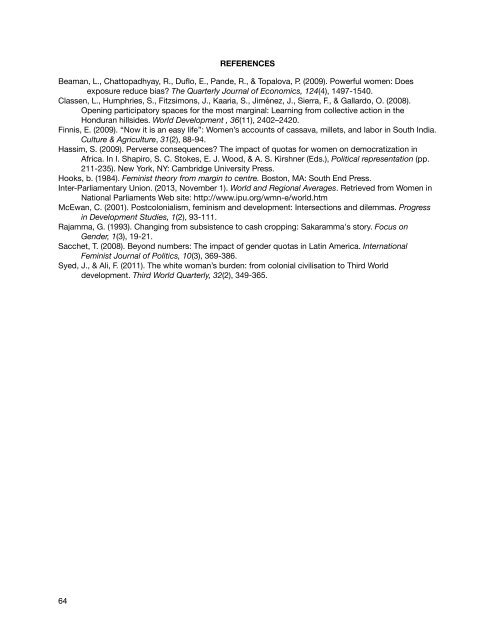Undercurrent-Issue-Fall-Winter-2014-3
Undercurrent-Issue-Fall-Winter-2014-3
Undercurrent-Issue-Fall-Winter-2014-3
You also want an ePaper? Increase the reach of your titles
YUMPU automatically turns print PDFs into web optimized ePapers that Google loves.
REFERENCESBeaman, L., Chattopadhyay, R., Duflo, E., Pande, R., & Topalova, P. (2009). Powerful women: Doesexposure reduce bias? The Quarterly Journal of Economics, 124(4), 1497-1540.Classen, L., Humphries, S., Fitzsimons, J., Kaaria, S., Jiménez, J., Sierra, F., & Gallardo, O. (2008).Opening participatory spaces for the most marginal: Learning from collective action in theHonduran hillsides. World Development , 36(11), 2402–2420.Finnis, E. (2009). ‘‘Now it is an easy life’’: Women’s accounts of cassava, millets, and labor in South India.Culture & Agriculture, 31(2), 88-94.Hassim, S. (2009). Perverse consequences? The impact of quotas for women on democratization inAfrica. In I. Shapiro, S. C. Stokes, E. J. Wood, & A. S. Kirshner (Eds.), Political representation (pp.211-235). New York, NY: Cambridge University Press.Hooks, b. (1984). Feminist theory from margin to centre. Boston, MA: South End Press.Inter-Parliamentary Union. (2013, November 1). World and Regional Averages. Retrieved from Women inNational Parliaments Web site: http://www.ipu.org/wmn-e/world.htmMcEwan, C. (2001). Postcolonialism, feminism and development: Intersections and dilemmas. Progressin Development Studies, 1(2), 93-111.Rajamma, G. (1993). Changing from subsistence to cash cropping: Sakaramma's story. Focus onGender, 1(3), 19-21.Sacchet, T. (2008). Beyond numbers: The impact of gender quotas in Latin America. InternationalFeminist Journal of Politics, 10(3), 369-386.Syed, J., & Ali, F. (2011). The white woman’s burden: from colonial civilisation to Third Worlddevelopment. Third World Quarterly, 32(2), 349-365.64


